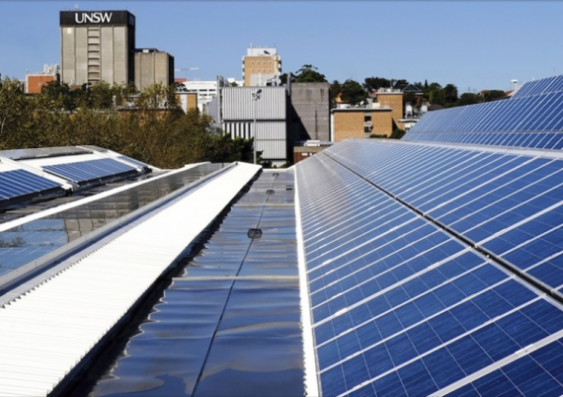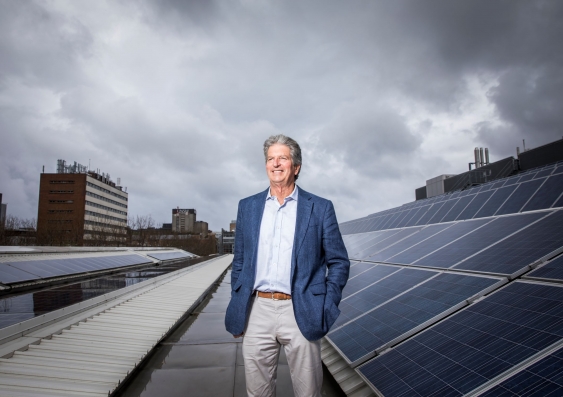UNSW Sydney solar experts say we need bespoke technology designed to recycle important elements inside solar panels.
In Australia, solar power is one of the countryâs leading renewable energy sources with rooftop solar PV installed in more than 3.3 million homes.
Sadly, approximately 90 per cent of these systems might ultimately end up in landfill once they need to be replaced.
A 2016Â Â by the International Energy Agency estimates Australia will generate 145,000 tonnes of waste from PV panels by 2030.
UNSW solar expert, Dr Richard Corkish from the Australian Centre for Advanced Photovoltaics, based at UNSW Sydneyâs School of Photovoltaics and Renewable Energy Engineering, says the sustainability principles of âReduce, Reuse and Recycleâ should be applied to the end-of-life management of all PV modules.
âWeâve seen a huge uptake in both small-scale and large-scale PV deployment in the last decade as the world moves towards renewable energy sources,â he says.
âThe industry standard for most solar panelsâ lifespan is 25 to 30 years which means solar systems installed more than 15 years ago will soon be approaching their end-of-life.
âAdditionally, in the last decade, weâre seeing a growing trend of replacing PV modules even though they are in perfect working condition. A lot of people installed small expensive systems some years ago but rather than adding on to them, theyâve been convinced to replace them altogether.
âFrom a manufacturing point of view, the photovoltaics research community is trying to lengthen the life of the modules by making them more resilient to the environment, particularly moisture and oxygen.
âThe goal is to extend the life, so they last up to 50 years which means we wonât need to make nearly as many in the future. If we suddenly need to ramp manufacturing, weâll find there are some materials, including silver and aluminium, that will be at risk of being in low supply.â
Media enquiries
For enquiries about this story or interview requests, please contact Cecilia Duong.
Tel: (02) 9065 1740
Email: cecilia.duong@unsw.edu.au
Avoiding landfill
Up to 95 per cent of the materials used to make a solar panel can be recycled, with the most valuable parts being the silicon, aluminium frames, and silver - which is mainly used in the front contacts of the module.
For panels that are recycled, the most common process in Australia results in the panels being put through a standardised shredding machine where they are broken into smaller pieces. These pieces are then down-cycled into other products such as an additive in the production of construction bricks concrete or even roadbase. Â
Dr Rong Deng, Research Fellow from the UNSW School of Photovoltaics and Renewable Energy Engineering, says the biggest problem with the current process is the inability to extract the rare metals in the panels whilst keeping costs down.
âTo be reused, solar panels components need to be carefully separated to avoid contamination with other materials. Manufacturers will only reuse materials that have a high purity â which is difficult to achieve,â says Dr Deng, who was named in the 2022  Healthcare and Science List.
âThe current process is a temporary solution. Itâs great if all panels are recycled because we want to avoid it ending up in landfill. But if we think ahead, the materials weâre using right now are not always going to be readily available later.
âThe silver embedded inside the cells is highly sought-after because of its value in pure form. However, the challenge we face is how we do that cheaply and without adding to our carbon footprint.
âBut if continue down the path of using non-specialised technology to recycle PV modules, then weâll still continue to end up with parts that are contaminated with other materials which is not a sustainable solution.â
Cost of disposal
The management and disposal of PV modules varies between each state and territory. In Australia, only Victoria have officially banned solar panels from ending up in landfill, meaning they need to be taken to e-waste drop off points to be recycled. Under a new proposed , Queenslanders will soon be banned from dumping solar panels in landfill in the next decade.
However, consumers and businesses can expect to pay between $10 to $20 per panel to recycle, plus any freight or removal fees. In states that do not have a policy on recycling solar panels, this extra cost could be a massive deterrent to recycling and more of a reason to dispose of them in a landfill facility, says Dr Deng.
âIf you have a system of 10 panels on your roof, youâre going to pay at least $200Â to dispose of them,â she says.
âT³ó±ðÌý have signalled potentially adding PV modules to the Product Stewardship Scheme. Similar schemes are already in place for other goods such as car tyres and plastic bottles.â
A Product Steward Scheme is an approach which involves taking responsibility for the full life cycle of a product. It promotes and supports the principles of circular economy and schemes can be voluntary, made mandatory by Government or done in partnership with industry.
Dr Corkish says if everyone who imports, designs, produces, sells, and uses PV modules has a shared responsibility for reducing the environmental impact â then it would further incentivise manufacturers to invest in better PV recycling technology.
âThere needs to a system in place where costs are recouped from the industry so that cost imposed on new modules can pay for the recycling of the old ones,â says Dr Corkish, Chief Operating Officer of the Australian Centre for Advanced Photovoltaics.
âHowever, the caveat is in the long service life of PV modules. Because they last up to 30 years, the companies who are currently active in the market were not necessarily the ones manufacturing the older panels on rooftops today.
âBut the bottom line is that end-of-life PV systems will be a future environmental problem unless we address it now.â
Better and cheaper testing
For newer models of PV systems, homeowners can track and compare energy output through an online system or mobile app. However, Dr Corkish says some homes are prematurely upgrading their solar systems well before they need to.
âWhilst thereâs huge potential for reuse of PV modules, the lack of affordable testing to ensure the panels still meet electrical safety standards means many make their way to landfill,â he says.
âSometimes the backsheets are the first thing to go but they can sometimes be repaired or replaced. If the diodes fail, they can be replaced too.
âSometimes panels still havenât reached their full life yet and we donât want that to go to waste.â
Is the future of PV recycling looking bright?
Australia is no stranger to the solar PV system. UNSW Engineeringâs Professor Martin Green is a world-renowned expert, leading the development of market-dominating PERC technology which has improved the quality of both the top and the rear surface of standard silicon solar cells.
Dr Deng recognises that recycling of PV modules in Australia is still in its infancy with only a handful of recycling facilities available in the country. She says thereâs a lot to learn from countries in Europe who are far ahead in terms of addressing the problem.
Early adopters of small-scale rooftop PV systems, such as Germany and Netherlands, have been acting with much more urgency in terms of finding viable technologies to recycle older PV panels, which are coming up to their end-of-life phase.
âCountries in Europe have built the prototypes for separation technologies and have several pilot lines to test the feasibility. But most importantly, they have the motivation to do it,â she says. Â
âIn Australia, weâre still waiting for the waste bomb that is predicted when all these PV modules come to the end-of-life, so thereâs less incentive for local companies to invest in the technology.
âAt some point, there will not be enough landfill to dispose of PV modules â nor will there be enough resources to build them. So, itâs imperative we find a sustainable solution to recycle them now.â
Related stories
-

Solar panels aren't perfect yet â we can make them even better and cheaper
-

Solar is cheapest power, and a light-bulb moment showed we can cut costs further
-

UNSW awarded more than $29.3m for renewable energy research and development
-

UNSW Sydney solar pioneer wins Europe's biggest technology innovation prize



